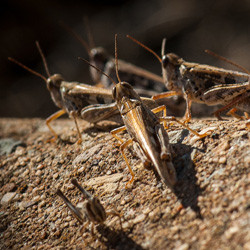Biological pest control
According to evolutionary ecology theory, disease risk is a function of host density. From this, one can deduce that hosts living at high densities are faced with a higher risk of contracting disease and should invest more in defence against parasites and pathogens. This hypothesis is known as positive density-dependent prophylaxis and is evident in various crop pests, including the African armyworm, Spodoptera exempta. However, the destructive agricultural pest Australian plague locust (APL), Chortoicetes terminifera, constitutes an exception to the above evolutionary principle. In this insect, certain key immune functions tend to be lower in groups than in solitary insects. The scope of the EU-funded LOCDIS project was to determine why certain species are present with such contrary behavioural and immunological strategies to combat disease transmission. In this context, the consortium investigated the spatial and temporal pattern of natural disease epizootics in APL populations. Using next-generation DNA sequencing they identified which microbial strains were associated with different locust field populations. Next, they compared the immune function and disease resistance in locusts raised in groups or in solitary conditions. To this end, they tested the survival of different insects against the fungus Metarhizium acridum. They also quantified the impact of locust diet on immune function, host behaviour and disease resistance. Scientists discovered that dietary protein influenced immune responses to a greater extent than carbohydrates, but this was not sufficient to protect locusts from fungal disease. One theory proposed was that the fungus was feeding on the protein in the insect's haemolymph, thereby overcoming host immune effectors. In field locust populations, immune function was tightly associated with haemolymph protein content and body lipid content, clearly underscoring the importance of nutritional physiology to locust survival. These findings have obvious implications for pest outbreaks and the use of biological pesticides in the control of locust populations.







